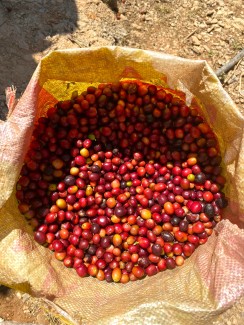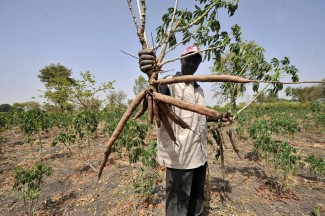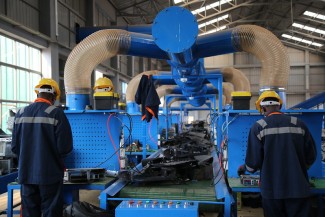On 30th and 31st July, almost 300 mm of rain fell on Banjul and the capital region[HS1] of The Gambia. The resulting flash floods directly affected more than 45,000 people. It was the worst floods seen in the country in the past 50 years. A few weeks later, an extreme rain event hit neighbouring Dakar, Senegal's capital, and caused severe damage to roads and infrastructure.
Uganda and Sudan were similarly affected this summer with floods that destroyed houses and infrastructure. The floods displaced thousands of people, disrupting lives and livelihoods.
Taken together, all these events showcase how least developed countries (LDCs) are at the forefront of the climate crisis and how much they stand to lose. According to the International Institute for Environment and Development, 69% of worldwide deaths in the past 50 years caused by climate-related disasters were in LDCs[HS2] . This affects livelihoods too. It was reported that Malawi annually lost up to 1.7% of its gross domestic product between 2005 and 2010 due to extreme climate events.
At COP 15, a target of $100 billion per year in financing was set providing significant financing opportunities for developing countries. There has been some movement towards this through dedicated multilateral climate funds such as the Green Climate Fund, the Global Environmental Facility and the LDC and Adaptation Funds. However, there is still a long way to go as the target has not yet been met. Additionally, within the funding there is an imbalance towards mitigation and not enough on adaptation which is a key issue for the LDCs.
In the past, trade has been accused of contributing to environmental degradation and of fuelling climate change. It is now seen as a powerful channel to disseminate more environmentally friendly technologies and achieve efficiency gains.
These aspects will prove essential for LDCs to properly mitigate, and more importantly, adapt to climate change. Indeed, trade provides opportunities to create win-wins for both climate mitigation and adaptation. This is where Aid for Trade (AfT) comes in to support them in achieving these goals and continuing their march towards sustainable economic growth.
The 2022 WTO/OECD Aid for Trade at a Glance report highlights how environmental aspects are being incorporated into AfT whereby 93% of the LDCs that responded to the survey indicated that environmental objectives are featured in their development strategies. However, environment-related AfT may be somewhat generally overstated, with prior assessments through the OECD indicating that a stricter definition of environmental aspects could mean that fewer than 2% of the AfT projects would have a clear environmental purpose.
The 2022 report also notes that 69% of Aid for Trade projects that include climate-related objectives focused on mitigation in 2020, which compares to 47% for adaptation. The importance of adaptation objectives in commitments has however been growing, with a 77% increase in 2020.
At this point in time, LDCs and other vulnerable countries need to build their climate adaptation capacity. A recent WTO Climate Change Adaptation and Trade policy brief highlights that adaptation finance is particularly important for the poorest and most vulnerable countries with only 36% of climate finance dedicated to adaptation. While traditional export crops may suffer from more frequent floods, wildfires or drought, methods of production can adapt, and more climate resilient export products scaled up.
While there can be win-win investments to support climate mitigation through trade, such as the retention and growth of forests through export incomes from shea, gum Arabic or honey, it is time for Aid for Trade to fund more climate adaptation projects in LDCs.
This investment can build on a series of existing tools and avenues that are available to make sure that trade projects can increase adaptation capacities in LDCs.
Firstly, we need to link assessments in trade to action in climate policy and finance. These assessments are key to identify areas for adaptation capacity building through trade. The Enhanced Integrated Framework's Diagnostics Trade Integration Studies (DTIS) provide a framework and evidence to influence policy and programming. For the diagnostic of Tuvalu, a nation we all know will be impacted severely by climate change, over a quarter of the analysis was dedicated to climate. DTISs currently being developed in South Sudan and Zambia for instance also include deep dives into climate change and green value chain diversification.
These studies can leverage the already existing National Adaptation Plans devised by LDCs to find commonalities and see where aid for trade may apply to help them achieved some of their adaptation objectives.
While many of the EIF projects related to the environment have a focus on climate mitigation and environmental protection, we have also started to pilot a few trade and climate adaptation projects.
In Lesotho, we are working with farmers to promote sheltered horticulture production and allow them to better cope with increasingly erratic climates. In the Pacific, together with partners, we helped the reconstruction of Vanuatu's Port Vila seafront after Cyclone Pam. In Timor Leste, coffee farmers are mapping the risk of landslides with EIF and FairTrade Australia, and looking to adopt more sustainable soil and water management practices.
These projects are only the beginning in building climate adaptation capacities in LDCs. In the future, explicit trade links to climate adaptation investments, and visa-versa more climate consideration in trade investments need to be scaled up to better contribute to the climate resilience of LDC economies. LDCs need the resources and the tools to face the upcoming disasters and adapt to the new realities of the climate crisis, because one thing is certain, more disasters, and more extreme weather events will hit LDCs. The least a modern AfT framework can do is help the most vulnerable adapt and brace for them, and at the same time, harness opportunities through trade.
Together, through investing in trade and adaptation we can have a win for all.
----
This article is part of a series dedicated to climate and trade.
If you would like to reuse any material published here, please let us know by sending an email to EIF Communications: eifcommunications@wto.org.



